How to migrate blogs from WordPress.com to WordPress.org
In the article comparing the previous WordPress.com and WordPress.org platforms, the reader had the answer to the question: Which of the two is better between these two platforms? With WordPress.com, everything is pretty good until you want to go further with it. You want to install the plugin and customize your theme. You really want to start making money from your website and have full control over it.
Today's article will show you how to migrate your existing WordPress.com blog to WordPress.org (including images). The article will also show you how to keep search engine rankings for your site, along with how to redirect your current users to the new site. Are you ready? Start moving your WordPress.com blog to WordPress.org now!
How to migrate blogs from WordPress.com to WordPress.org
- Things you need before you start
- Steps to proceed
- Step 1: Export data from WordPress.com
- Step 2: Set up WordPress
- Step 3: Enter content into the self-hosted WordPress page
- Step 4: Enter your Blogroll Links
- Step 5: Put your WordPress.com blog into private mode
- Step 6: Redirect visitors and maintain SEO
- Frequently Asked Questions (FAQs)
- What happens to people who have subscribed to my WordPress.com site?
- How much does it cost to convert to WordPress.org?
- If I have already paid for WordPress.com, can I get a refund?
- Is my image broken?
- I registered my domain through WordPress.com, can I still move my site?
- Is my site broken when I convert?
Things you need before you start
You will need to have a good domain name and a good web hosting (web hosting) company about WordPress. As mentioned before, you should use Bluehost because Bluehost is the official hosting provider proposed by WordPress.
If your WordPress site already has a custom domain name, don't worry. This guide will also include that. Finally, you will need access to your WordPress.com account, so you can easily move all your posts, pages, images, comments and other data to your self-hosted WordPress website.
Steps to proceed
Step 1: Export data from WordPress.com
Log in to your WordPress.com account and access the blog's Dashboard page. Click Export in the Tools menu .

Clicking on the Export tool will take you to the new page where you will be asked to choose between Free or Guided Transfer .
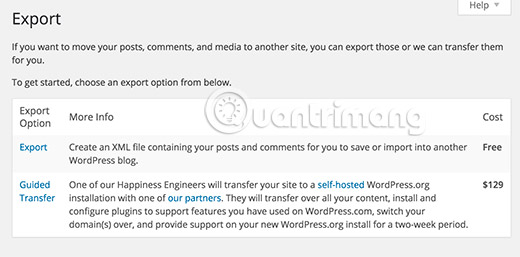
Select the Free option by clicking Export. On the next screen, you will be asked which data you want to export. Select ' All Content ' and click the Download Export File button. An XML file will be downloaded to your computer, containing all your posts, pages, images, comments, custom fields, categories, tags, navigation menus and other information.

Step 2: Set up WordPress
Now that you have exported your WordPress.com data, the next step is to set up a new WordPress installation on your web hosting. WordPress is easy to install and requires only a few clicks. After you've installed WordPress, it's time to enter your content into the new self-hosted WordPress website.
Step 3: Enter content into the self-hosted WordPress page
To import your old content from WordPress.com into your new website, you need to click the Tools> Import option in the WordPress.org dashboard.
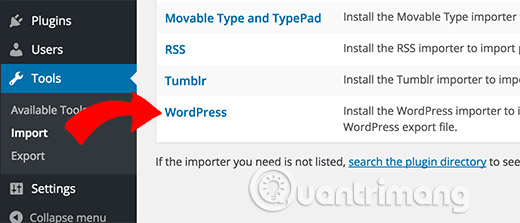
Next, click on WordPress. You will be asked to install the WordPress Importer plugin. After you install, activate and run this plugin. It will take you to a screen where you will be asked to upload the WordPress.com XML file that you downloaded in step 1 of this tutorial.
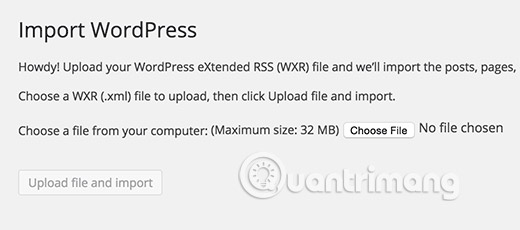
Note : If your file size is larger than 2MB, then you have two options. One is to ask your web hosting company to increase that temporary limit, so you can continue with this process. The second option will be splitting your file using the WXR file splitting tool.
(WXR download link: http://rangerpretzel.com/content/view/20/1/)
When you start importing data, you will have the option to assign the old content to the current user or create a new user. You will also have the option to import your old attachments (to make sure your images are imported with other data as well).
Step 4: Enter your Blogroll Links
If you used the Links feature on your WordPress.com blog to host blogroll or other links, then you need to follow these instructions to export and import them into the new website. Users who do not use this feature can always switch to step 5.
Blogroll Link is exported in OPML format. This is an XML format that allows you to export and import your links and link catalogs. Your WordPress.com link has an OPML file located at the following address:
http://example.wordpress.com/wp-links-opml.php
Replace 'example' with the subdomain of the WordPress.com blog you own. If you are using a custom domain for your WordPress.com blog, your OPML file can be accessed with a URL as follows:
http://www.example.com/wp-links-opml.php
Your OPML file will open in the browser window and you need to save it to your desktop. Press CTRL + S ( Command + S on Mac) to save the file on your computer.
Now that you have a backup of your WordPress.com links, the next step is to import them into WordPress.org. However, WordPress self-hosting does not have link managers enabled by default.
The first thing you need to do is install and activate the Link Manager plugin. After activation, the plugin will add a new entry in your WordPress admin bar named 'Links'.
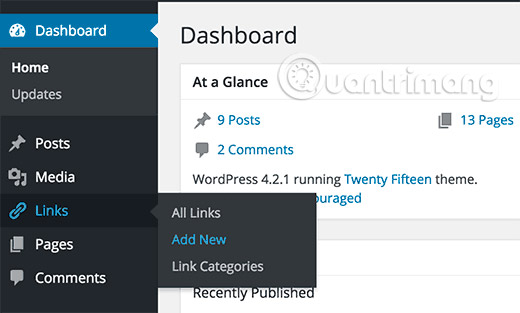
Your WordPress website currently has the ability to manage links and blog lists, of course, you can import them safely. Go to Tools> Import and click Blogroll to install OPML importer.
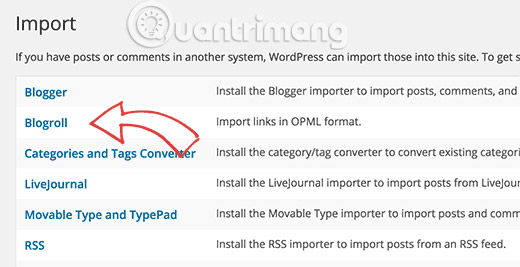
After installation, you will be redirected to importer. Where you need to upload the OPML file you saved earlier and click the Import OPML file button.
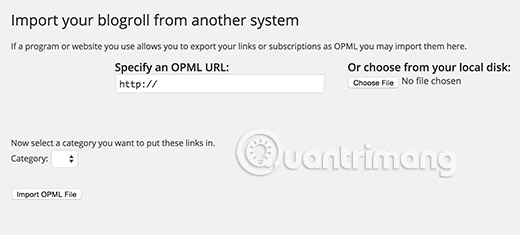
Now, WordPress will import your links and link catalogs from the OPML file. You can see the progress and when completed, you will see a success message.
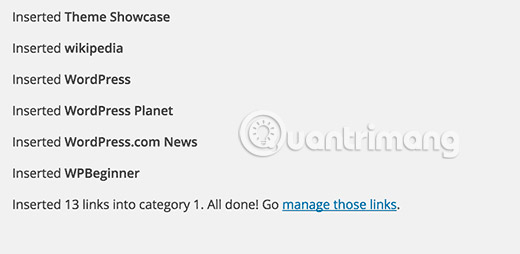
Step 5: Put your WordPress.com blog into private mode
The final step is to put your WordPress.com blog into private mode. If you don't want to redirect old users to your new site, continue to follow this step. Go to the Reading page in the Settings tab , from the WordPress.com Dashboard page and select the last option, ' I would like to blog me to be private, visible only to users I choose '.
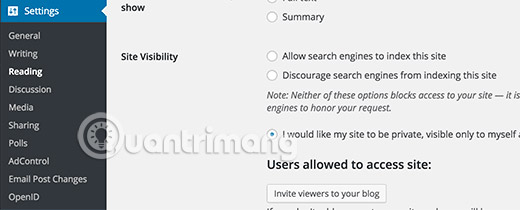
Note : If you have blogged for a while and you have a certain amount of loyal readers, then you should not waste this resource. Moreover, if your blog has been released for a while, chances are it has been indexed in Google and other search engines. You should keep all these factors and redirect your old users to the new blog.
Step 6: Redirect visitors and maintain SEO
Redirecting users to the new web with title 301 is the standard solution to keep search rankings, while moving a site from one location to another. Since you do not have access to .htaccess on WordPress.com, you cannot make any changes yourself to retain the search engine rankings. However, WordPress.com released a premium upgrade, called Site Redirect, to provide this functionality.
Access the dashboard of WordPress.com blog and click on the Store menu item . The upgrade you are looking for is called Site Redirect. At the time of writing this guide, this update has a fair price of 13 USD / year. This upgrade provides 301 redirects, allowing site visitors and search engines to automatically be redirected to your new site.
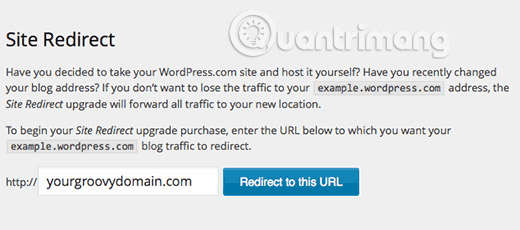
Some of you will wonder how long you should continue to pay for this Offsite redirect feature? The answer is as you like. However, there are many opinions that 2 years will be enough time for old users to remember your new domain name.
If you are changing the domain, another thing you want to do is update all in the post URL. If you've ever linked your posts, those links must also be updated.
Frequently Asked Questions (FAQs)
Here are the common questions when moving blogs from WordPress.com to WordPress.org.
What happens to people who have subscribed to my WordPress.com site?
Thankfully, WordPress.com allows you to move the number of people who have subscribed to your site with one condition. You must use the Jetpack plugin to add the same registration function you have at WordPress.com. When you install and activate the Jetpack plugin, you need to contact the WordPress.com team and ask them to move the subscriber to you. Hopefully in later versions of Jetpack, this will become easier and users will be able to do it themselves.
How much does it cost to convert to WordPress.org?
WordPress.org for free. However, there are some minimal web hosting costs.
If I have already paid for WordPress.com, can I get a refund?
Yes you can. If you recently purchased a custom domain or paid package from WordPress.com, you can ask them for a full refund.
Note: Domain registration can be canceled within 48 hours of registration. Packages and other purchases can be canceled within 30 days of purchase.
Is my image broken?
No, they will be fine. When you switch using the import file, all attached images will be downloaded and the link will be updated. However, one note is that if your image URL starts with files.wordpress.com, they will not be converted. If you find that the image URL has not changed and still points to WordPress.com, you should use the plugin to import the external image and it will take care of it.
I registered my domain through WordPress.com, can I still move my site?
Yes you can. WordPress believes in empowering users and giving them full control over their content. If you already have a domain name through WordPress.com, all you need is a web hosting account. You should set up with Bluehost or any other WordPress hosting provider. During the registration period, you will be asked if you have a domain or want to register a new domain name. Simply select the option ' I have a domain name ', and insert the domain you registered at WordPress.com. The next thing you will have to do is change the name for the server, to point to the hosting service provider. You can ask your web hosting provider to support this.
Is my site broken when I convert?
If you do it right, NO. The method suggested above will ensure that your site is never corrupted.
Hopefully, you find this guide useful for moving web pages from WordPress.com to WordPress.org. If you have any questions, please let us know by leaving comments in the comments section below!
Wish you a successful conversion!
See more:
- 10 most popular WordPress errors and how to fix them
- 11 security tips for WordPress blogs
- Manage WordPress from Android device
You should read it
- Why is WordPress free?
- What's new in WordPress 5.4?
- WordPress.com blog service collapsed because of a DoS attack
- How to add new posts on WordPress
- Enhance Wordpress security with Plug-in
- Add WordPress.com features to your blog
- Squarespace and WordPress - Which one is better?
- Assign SSL security mechanism to WordPress blog
May be interested
- Build a blog with WordPress
 most of those who are new to blogging often use free services with fixed, poor options.
most of those who are new to blogging often use free services with fixed, poor options. - WordPress.com blog service collapsed because of a DoS attack
 the server hosting the blog wordpress.com was hacked from dos last saturday until the end of tuesday morning (february 19), making it impossible for users of this site to log in and post on their blogs.
the server hosting the blog wordpress.com was hacked from dos last saturday until the end of tuesday morning (february 19), making it impossible for users of this site to log in and post on their blogs. - Good habits for computer users
 many people chat and write blogs and still finish their work because they have applied some basic principles so as not to be flooded with hundreds of new e-mails.
many people chat and write blogs and still finish their work because they have applied some basic principles so as not to be flooded with hundreds of new e-mails. - Basic steps to create a blog with Tumblr
 have you been tired of personal blogs with a long life span, problems with maintenance, updates and upgrades? today, tipsmake.com will introduce to you blog creation tool - tumblr completely free.
have you been tired of personal blogs with a long life span, problems with maintenance, updates and upgrades? today, tipsmake.com will introduce to you blog creation tool - tumblr completely free. - How to use Net Writer to write blogs on Windows 10 - WordPress and Google Blogger support
 net writer application supports users to write blogs right on the application without direct access.
net writer application supports users to write blogs right on the application without direct access. - How to turn on HTTPS for your blog site
 if you want people to access your blog via https, you can enable https and https redirection.
if you want people to access your blog via https, you can enable https and https redirection. - Adding dynamic widgets to WordPress blogs without using code
 if you own a wordpress site, do you want to display different widgets on every page in your blog? how to do this in wordpress?
if you own a wordpress site, do you want to display different widgets on every page in your blog? how to do this in wordpress? - How to embed videos and articles from Facebook into any Website
 facebook's embedded posts feature allows users to embed any article from facebook (such as images, videos, status ...) into any website or blog. users can embed any content shared on facebook pages or personal facebook pages, as long as the content is shared with everyone in public (public) mode.
facebook's embedded posts feature allows users to embed any article from facebook (such as images, videos, status ...) into any website or blog. users can embed any content shared on facebook pages or personal facebook pages, as long as the content is shared with everyone in public (public) mode. - How to Migrate from Windows to Ubuntu
 when migrating from windows to ubuntu, there are a few things you might need to reflect over, like how to cope the new system, the new interface, and how to adapt to ubuntu in general, and of course, how to transfer your personal files...
when migrating from windows to ubuntu, there are a few things you might need to reflect over, like how to cope the new system, the new interface, and how to adapt to ubuntu in general, and of course, how to transfer your personal files... - The magical moments of the web (part 2)
 the birth of wikis, blogs, and the catastrophe of hurricane katrina, the first experience with a handy webmail service ... it looks simple, but it's a huge milestone. important in the development of the web.
the birth of wikis, blogs, and the catastrophe of hurricane katrina, the first experience with a handy webmail service ... it looks simple, but it's a huge milestone. important in the development of the web.










 How to install Google Roboto fonts on Windows, Mac and Linux
How to install Google Roboto fonts on Windows, Mac and Linux How to update URLs when moving WordPress sites
How to update URLs when moving WordPress sites How much does it cost to build a WordPress website?
How much does it cost to build a WordPress website? Why is WordPress free?
Why is WordPress free? How to import images from external sources into WordPress
How to import images from external sources into WordPress